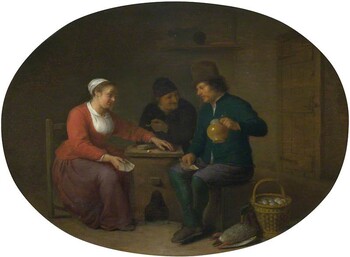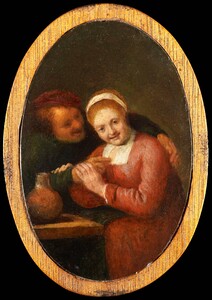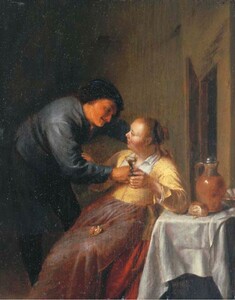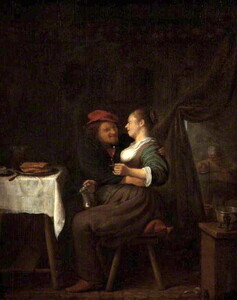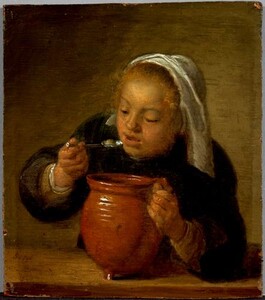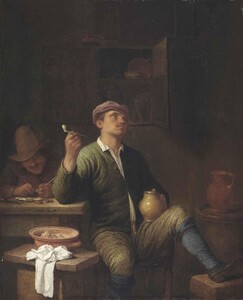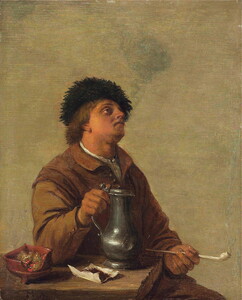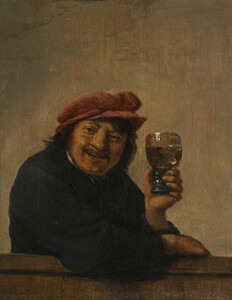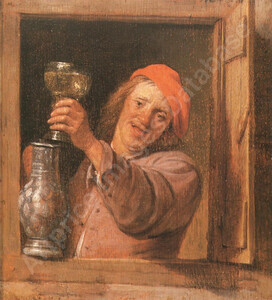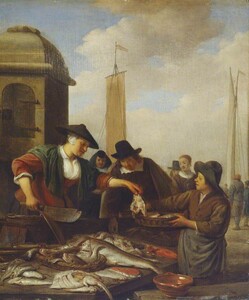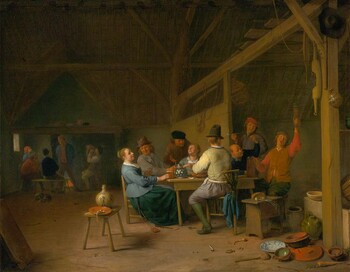4.500 €
A man courting a woman in front of a farmhouse
Oil on copper : 15,4 X 20,1 cm
Unsigned
Frame : 24,8 X 29,2 cm
In short
Sorgh was an important, versatile painter from Rotterdam, where he had been influenced by Herman and Cornelis Saftleven, and probably through them by the Flemish genre scene painter David Teniers II, as one can see here.
Sorgh painted several courtship scenes.
About Hendrick Martensz. Sorgh
Dutch painter
Rotterdam circa 1610 – 1670 Rotterdam
Versatile painter of genre scenes (peasant and bourgeois scenes), market scenes and also of some landscapes (maritime subjects and river landscapes), religious scenes, portraits and still lives.
His father, Maerten Claesse Rokes (or Rochusse), was a ferry skipper on the line Rotterdam – Dordrecht, his mother was born in Antwerp. Both Sorgh’s parents had already been married and lost their partner: his father had already two daughters, his mother, who was a rich woman, had five children.
His father carried farmers and their cattle over the river Maas, especially on market days, hence the name market skipper. Because of the great care with which he handled his cargo he was nicknamed “Sorgh”, which means care. Our painter also adopted this surname and also became “marktschipper” to Dordrecht from the middle of the 1630s (circa 1633-1636) until his death in 1670. In his later life it must largely have been a ceremonial post, as his artistic career flourished.
Sorgh was well-connected and got several appointments to civic offices in Rotterdam: in 1657 he was appointed as bread weigher, two years later as fire deputy.
In 1669, the year before his death, he became head (“hoofdman”) of the Painters’ Guild of Rotterdam, where he had become a Master in the year 1636/37.
In 1633 Sorgh married the daughter of a rich merchant from Delfshaven, near Rotterdam. A pair of portraits in the collection of the Duke of Westminster were traditionally thought to represent Sorgh and his wife Adriaantje Hollaer and until very recently they were said to have been painted by Rembrandt. Both portraits have indeed a fake Rembrandt signature. Now they are being seen as early portraits by Carel Fabritius, painted circa 1642, shortly after he joined Rembrandt’s workshop.
Sorgh was, according to Arnold Houbraken (1660 – 1719), who published in 1718 his famous “De groote schouburgh der Nederlantsche konstschilders en schilderessen”, a biography of all important Dutch painters, a pupil of Willem Pietersz. Buytewech and of David Teniers. There seems to have been a family link between Sorgh and both his masters.
As so often with Houbraken it is difficult to evaluate the value of his remarks:
- Buytewech (Rotterdam 1591/92 – 1624 Rotterdam) was indeed active in Rotterdam, but he died when Sorgh was 13 or 14 years old, so maybe he just gave him some basic lessons.
- As to Teniers, Houbraken did not specify if he meant David I (Antwerp 15825 – 1649 Antwerp) or his famous son David II (Antwerp 1610 – 1690 Brussels). One can not detect any influence of David I in the artistic production of Sorgh. As to David II he had the same age as Sorgh. Maybe Houbraken meant that our painter was, just like the other Rotterdam genre scene specialists Pieter de Bloot (1601 – 1658), Cornelis Saftleven (1607 – 1681) and his younger brother Herman Saftleven (1609 – 1685), strongly influenced by David Teniers the Younger.
Sorgh’s early works, stable interiors with still lifes were influenced by Herman and Cornelis Saftleven, who were then active in Rotterdam.
Most of Sorgh’s tavern scenes date from the 1640s, ours is dated 1652. From the early 1650s he painted outdoor market scenes on the quaysides of Rotterdam, small-scale portraits and marine pictures.
Sorgh was the master of his brother-in-law, Crijn Hendricksz. Volmarijn, and of Abraham Diepraam.
Why should you buy this painting?
Because it is a nice, detailed composition on copper.
Comparative paintings
Click photos for more details

